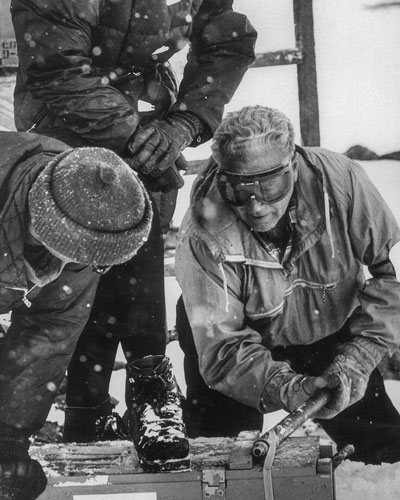
Early in life, Montgomery Atwater’s aspirations weren’t to work with snow and avalanches. In fact, after graduating from Harvard in 1926 with a degree in English literature, the Oregon native began writing works of nonfiction. But World War II brought Atwater, who went by the nickname Monty, to Colorado’s Camp Hale where he’d join the 10th Mountain Division. And like many of his comrades, Atwater’s experiences in the 10th Mountain Division would lead to a dramatic impact on American skiing.
After fighting in northern Europe and in the Battle of Kiska on Alaska’s Aleutian Islands, Atwater moved to Utah at the suggestion of fellow 10th vet Sverre Engen, where he took a job with the Wasatch National Forest managing public safety in Little Cottonwood Canyon. It was the mid 1940s, and snow science and avalanche control weren’t in anyone’s wintertime lexicon. But Atwater quickly changed that.
He developed procedures for mapping avalanche paths and managing them using surplus military and mining munitions; he hired a team of the country’s first snow rangers including scientist Ed LaChapelle in 1952; and he published books with supervisor Felix Koziol including Alta Avalanche Studies (1949) and Avalanche Handbook (1953). In 1952, Atwater secured permission to use heavy artillery—ancient French 75 mm guns—to trigger avalanches. Later, while serving as Avalanche Control Chief for the 1960 Squaw Olympics and in a similar role for Portillo, Chile’s 1966 Alpine World Ski Championships, he would refine the craft.
At the same time, alongside Frank Parsoneault, the engineer behind the “Fireball” baseball-pitching machine, Atwater developed a similar mechanism that could spit projectiles 400 yards using compressed air. According to avalanche and explosive specialist John Brennan, the duo sold 63 of their Mark 10 Avalaunchers in 1962, their first year in business. And while accidents plagued early models, more than 200 Avalaunchers are still in use globally today.
“I feel privileged to have been fated to play my part,” Atwater wrote in his 1968 memoir The Avalanche Hunters, widely considered the snow-safety worker’s bible. “I have loved every minute of it: the triumphs, the defeats; the frustrations, the half victories; the controversies, the Hearts games; the rescues that ended in tears and those that ended in the nearest bar.”
In October 1973, three year’s before Atwater’s death, the National Ski Patrol organized a meeting in California’s Yosemite National Park to make a major pronouncement in avalanche safety. Together with the U.S. Forest Service and the National Park Service, they officially declared Montgomery Atwater “the father of snow avalanche work in the United States.”










Monty Atwater was also one of the first people in the USA to do heliskiing, when he did a survey of the terrain at Mineral King. Check out the “Beginnings” essay on the website http://www.heliskihistory.com for details.